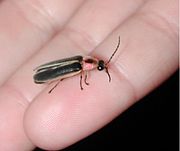
Animal communication is the transfer of information from one or a group of animals to one or more other animals that affects the current or future behavior of the receivers. Information may be sent intentionally, as in a courtship display, or unintentionally, as in the transfer of scent from predator to prey with kairomones. Information may be transferred to an "audience" of several receivers. Animal communication is a rapidly growing area of study in disciplines including animal behavior, sociology, neurology and animal cognition. Many aspects of animal behavior, such as symbolic name use, emotional expression, learning and sexual behavior, are being understood in new ways.

Within evolutionary biology, signalling theory is a body of theoretical work examining communication between individuals, both within species and across species. The central question is when organisms with conflicting interests, such as in sexual selection, should be expected to provide honest signals rather than cheating. Mathematical models describe how signalling can contribute to an evolutionarily stable strategy.
Dr. William H. "Bill" Cade is a biologist and a former president of the University of Lethbridge. He researches the role of acoustic signals in field cricket mating behaviour.

In animal communication, an alarm signal is an antipredator adaptation in the form of signals emitted by social animals in response to danger. Many primates and birds have elaborate alarm calls for warning conspecifics of approaching predators. For example, the alarm call of the blackbird is a familiar sound in many gardens. Other animals, like fish and insects, may use non-auditory signals, such as chemical messages. Visual signs such as the white tail flashes of many deer have been suggested as alarm signals; they are less likely to be received by conspecifics, so have tended to be treated as a signal to the predator instead.
A semiochemical, from the Greek σημεῖον (semeion), meaning "signal", is a chemical substance or mixture released by an organism that affects the behaviors of other individuals. Semiochemical communication can be divided into two broad classes: communication between individuals of the same species (intraspecific) or communication between different species (interspecific).
Interspecies communication is communication between different species of animals, plants, or microorganisms.

Teleogryllus oceanicus, commonly known as the Australian, Pacific or oceanic field cricket, is a cricket found across Oceania and in coastal Australia from Carnarvon in Western Australia and Rockhampton in north-east Queensland

Mobbing in animals is an antipredator adaptation in which individuals of prey species mob a predator by cooperatively attacking or harassing it, usually to protect their offspring. A simple definition of mobbing is an assemblage of individuals around a potentially dangerous predator. This is most frequently seen in birds, though it is also known to occur in many other animals such as the meerkat and some bovines. While mobbing has evolved independently in many species, it only tends to be present in those whose young are frequently preyed upon. This behavior may complement cryptic adaptations in the offspring themselves, such as camouflage and hiding. Mobbing calls may be used to summon nearby individuals to cooperate in the attack.

Aggressive mimicry is a form of mimicry in which predators, parasites, or parasitoids share similar signals, using a harmless model, allowing them to avoid being correctly identified by their prey or host. Zoologists have repeatedly compared this strategy to a wolf in sheep's clothing. In its broadest sense, aggressive mimicry could include various types of exploitation, as when an orchid exploits a male insect by mimicking a sexually receptive female, but will here be restricted to forms of exploitation involving feeding. For example, indigenous Australians who dress up as and imitate kangaroos when hunting would not be considered aggressive mimics, nor would a human angler, though they are undoubtedly practising self-decoration camouflage. Treated separately is molecular mimicry, which shares some similarity; for instance a virus may mimic the molecular properties of its host, allowing it access to its cells. An alternative term, Peckhamian mimicry, has been suggested, but it is seldom used.

The Túngara frog is a species of frog in the family Leptodactylidae. It is a small nocturnal terrestrial frog found in Mexico, Central America, and the northeastern regions of South America.
A mating call is the auditory signal used by animals to attract mates. It can occur in males or females, but literature is abundantly favored toward researching mating calls in females. In addition, mating calls are often the subject of mate choice, in which the preferences of one gender for a certain type of mating call can drive sexual selection in a species. This can result in sympatric speciation of some animals, where two species diverge from each other while living in the same environment.

Crickets are orthopteran insects which are related to bush crickets, and, more distantly, to grasshoppers. In older literature, such as Imms, "crickets" were placed at the family level, but contemporary authorities including Otte now place them in the superfamily Grylloidea. The word has been used in combination to describe more distantly related taxa in the suborder Ensifera, such as king crickets and mole crickets.

Seismic or vibrational communication is a process of conveying information through mechanical (seismic) vibrations of the substrate. The substrate may be the earth, a plant stem or leaf, the surface of a body of water, a spider's web, a honeycomb, or any of the myriad types of soil substrates. Seismic cues are generally conveyed by surface Rayleigh or bending waves generated through vibrations on the substrate, or acoustical waves that couple with the substrate. Vibrational communication is an ancient sensory modality and it is widespread in the animal kingdom where it has evolved several times independently. It has been reported in mammals, birds, reptiles, amphibians, insects, arachnids, crustaceans and nematode worms. Vibrations and other communication channels are not necessarily mutually exclusive, but can be used in multi-modal communication.

Soundscape ecology is the study of the acoustic relationships between living organisms, human and other, and their environment, whether the organisms are marine or terrestrial. First appearing in the Handbook for Acoustic Ecology edited by Barry Truax, in 1978, the term has occasionally been used, sometimes interchangeably, with the term acoustic ecology. Soundscape ecologists also study the relationships between the three basic sources of sound that comprise the soundscape: those generated by organisms are referred to as the biophony; those from non-biological natural categories are classified as the geophony, and those produced by humans, the anthropophony.

Marlene Zuk is an American evolutionary biologist and behavioral ecologist. She worked as professor of biology at the University of California, Riverside (UCR) until she transferred to the University of Minnesota in 2012. Her studies involve sexual selection and parasites.

Advertising in biology means the use of displays by organisms such as animals and plants to signal their presence for some evolutionary reason.
Rohini Balakrishnan is an Indian bioacoustics expert. She is a senior Professor and Chair of the Centre for Ecological Sciences at the Indian Institute of Science (IISc), Bengaluru. Her research focuses on animal behavior through the lens of animal communication and bioacoustics.
Condition-dependent signaling is a component of sexual selection. Its exact definition remains elusive due to the vagueness of the terms “condition” and “signaling”. It examines which conditions favor the extravagant displays and ornaments, or signals, some organisms poses, despite their lack of evolutionary value in terms of fitness.

Communication occurs when an animal produces a signal and uses it to influences the behaviour of another animal. A signal can be any behavioural, structural or physiological trait that has evolved specifically to carry information about the sender and/or the external environment and to stimulate the sensory system of the receiver to change their behaviour. A signal is different from a cue in that cues are informational traits that have not been selected for communication purposes. For example, if an alerted bird gives a warning call to a predator and causes the predator to give up the hunt, the bird is using the sound as a signal to communicate its awareness to the predator. On the other hand, if a rat forages in the leaves and makes a sound that attracts a predator, the sound itself is a cue and the interaction is not considered a communication attempt.
Reproductive interference is the interaction between individuals of different species during mate acquisition that leads to a reduction of fitness in one or more of the individuals involved. The interactions occur when individuals make mistakes or are unable to recognise their own species, labelled as ‘incomplete species recognition'. Reproductive interference has been found within a variety of taxa, including insects, mammals, birds, amphibians, marine organisms, and plants.















